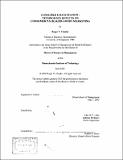| dc.contributor.advisor | John D.C. Little. | en_US |
| dc.contributor.author | Chacko, Roger V. (Roger Verghis), 1967- | en_US |
| dc.contributor.other | Sloan School of Management. | en_US |
| dc.date.accessioned | 2011-11-18T20:55:38Z | |
| dc.date.available | 2011-11-18T20:55:38Z | |
| dc.date.copyright | 2002 | en_US |
| dc.date.issued | 2002 | en_US |
| dc.identifier.uri | http://hdl.handle.net/1721.1/67171 | |
| dc.description | Thesis (S.M.)--Massachusetts Institute of Technology, Sloan School of Management, 2002. | en_US |
| dc.description | Includes bibliographical references (leaves 84-87). | en_US |
| dc.description.abstract | The Consumer Packaged Goods (CPG) industry has existed for decades with a high household penetration. Individual firms started out as small family owned businesses and then gradually became more "industrialized" via acquisitions. Historically, a low capital cost of entry, as well as high geographic dispersion encouraged fragmentation of competition. Overcapacity encouraged product proliferation; relatively low profitability produced little innovation, reducing the overall loyalty of consumers to CPG products today. Consumer habits changed quickly with the introduction of new offerings, further pressuring CPG manufacturers. A key CPG issue today is how to reduce cost base and overcapacity to enable investment in innovation, and branding. Cost reduction is expected from simplification (SKU's, products, lines etc), capacity consolidation, and a reduction in the fixed cost component of production. It is the belief that value creating innovation in the industry will enable the CPG industry to regain relevance and loyalty with the consumer while being more efficient (reducing costs), and enabling the investment necessary to sustain profitable growth. The annual organic growth in the CPG industry ranges between 2-6%. This thesis analyzes the effects of technology on marketing, as a value creating catalyst for profitable growth. The analysis starts with a review of the frameworks on strategy proposed by Hax, evolutions in consumer shopping behavior by Falk, as well as developments in technology based marketing by Coviello. The thesis further reviews practical technology applications currently in the CPG field. The consumer survey section in the thesis evaluates three technology device concepts (FAST LANE, PRODUCT GPS, and AUTO REORDER) that were developed using technology lead-users. The information presented and conclusions argued in this thesis suggest that the technology device concepts have a strong value creating effect in marketing and on the business; a benefit that is appropriated to the consumer, the retailer, and the CPG manufacturer. The final pillar in the survey is an interview with two major retailers in the Boston area that validate the potential and willingness to implement such mutually value creating programs. | en_US |
| dc.description.statementofresponsibility | by Roger V. Chacko. | en_US |
| dc.format.extent | 87 leaves | en_US |
| dc.language.iso | eng | en_US |
| dc.publisher | Massachusetts Institute of Technology | en_US |
| dc.rights | M.I.T. theses are protected by
copyright. They may be viewed from this source for any purpose, but
reproduction or distribution in any format is prohibited without written
permission. See provided URL for inquiries about permission. | en_US |
| dc.rights.uri | http://dspace.mit.edu/handle/1721.1/7582 | en_US |
| dc.subject | Sloan School of Management. | en_US |
| dc.title | Consumer emancipation : technology effects on consumer packaged-goods marketing | en_US |
| dc.type | Thesis | en_US |
| dc.description.degree | S.M. | en_US |
| dc.contributor.department | Sloan School of Management | |
| dc.identifier.oclc | 50742084 | en_US |
